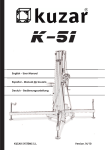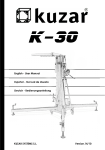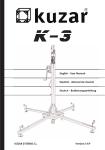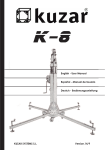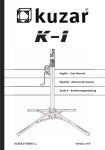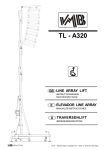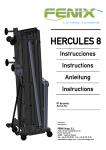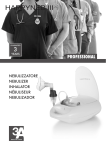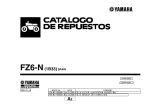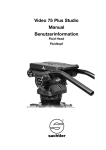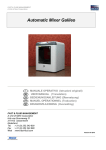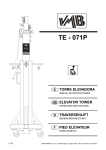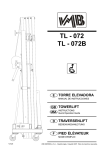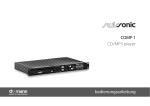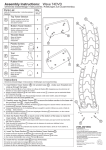Download C - Kuzar
Transcript
English - User Manual Español - Manual de Usuario Deutch - Bedienungsanleitung KUZAR SYSTEMS S.L. Version.15/09 300 kg (661.4 lb) 5.95 m (19.52’) KUZAR SYSTEMS S.L. C/ Ciudad de Ferrol Nº8 Pol.Ind. Fuente del Jarro 46988 Paterna - Valencia (Spain) Made in Spain (EU) Manual de usuario propiedad de KUZAR SYSTEMS S.L. Deposito legal y copyright 2014. Todos los derechos reservados. K-50 2 A - Reenvios de poleas / Pulleys sets B - Set piezas cabrestante / Winch set C - Set piezas de la base / Base set D - Set del estabilizador / Stabilizer set Soporte Brazos / Forks support 2196 Brazos de carga / Forks 2159 A Tramo 6 / Section 6 1360 Tramo 5 / Section 5 1359 Tramo 4 / Section 4 1358 Tramo 3 / Section 3 1357 Tramo 2 / Section 2 1356 Tramo 1 / Section 1 Base 1355 Carro D Lifting carriage 1223 Pata larga K-40 / K-40 Long leg B C Pata corta K-40 / K-40 Short leg 1222 3 Tornillo / Screw 1029 Arandela / Washer 8001 Gatillo KAT / KAT Lock Taco Gatillo/ Lock rest 2138 2185 2156 2157 4 A Vista en Planta superior / Top view A.4 A.5 A.2 A.2 A.2 A.2 A.1 A.1 - Reenvío superior Tramo 1 Base / Upper pulley set on Section 1 Base 2166 2008 1032 8004 8004 2167 8001 1027 5 A.2 - Reenvío superior Tramos 2 a 5/ Upper pulley set on sections 2 to 5 2008 2179 2175 8001 1032 8004 1027 8004 8001 1027 A.3 - Reenvío inferior / Lower pulley set 8004 A.9 A.8 2008 1032 2174 8001 2175 8004 1027 8001 1027 8001 1027 1027 1027 1027 A.4 - Fijación final de cable / Cable fixation 1026 1046 8004 9050 8001 8001 8001 1114 8013 7006 1026 6 A.5 - Rodillo Nylon / Nylon roller 2177 7002 8003 1033 A.6 - Freno de Inercia / Inertial break 1026 2146 A.7 - Tornillo fijación soporte brazos / Fixation screw for the forks support 2144 1004 1043N 2145 A.8 - Taco tope barras superior / Upper stop piece 2143 2142 8009 1030 8009 1030 7007 A.9 - Taco tope barras inferior / Lower stop piece 2176 1042 1042 7 B Tornillo / Screw 1028 Arandela / Washer 8003 Tuerca / Nut 7002 Cable de acero / Steel cable 9050 2173N Placa cabrestante / Winch support plate 2193 Placa tirantes / Strut support plate Tornillo / Screw 1036 Arandela / Washer 8006 Tuerca / Nut 7001 4004 Cabrestante / Winch 1036 Tornillo / Screw 8001 Arandela / Washer 7001 Tuerca / Nut 8 C Apoyo derecho / Right strut Apoyo izquierdo / Left strut 2137 2136 Pomo transporte patas / Transport security knob 2190 1047 Tornillo / Screw 8004 Arandela / Washer 7006 Tuerca / Nut 2189 Gatillo patas / Security leg lock 2187 Base K-50 1020 Tornillo / Screw 8001 Arandela / Washer 7001 Tuerca / Nut 1022 Tornillo / Screw 8004 Arandela / Washer 7006 Tuerca / Nut 2119 Nivel de Burbuja / Spirit level 5004 1022 8004 7006 Rueda /Wheel K-50 Tornillo / Screw Arandela / Washer Tuerca / Nut 9 D Estabilizador completo / Complete stabilizer kit 2168 2169 7010 7009 1041 2170 1015 8009 2171 2172 8006 1003 10 LISTA DE REPUESTOS / SPARE PARTS LIST Code/Código Description/Descripción 1003 Tornillo allen M8 x 16 / Allen screw M8 x 16 1004 Tornillo cónico M5 x 12 / Conic screw M5 x 12 1015 Tornillo allen M12 x 25 / Allen screw M12 x 25 1020 Tornillo allen M8 x 25 / Allen screw M8 x 25 1022 Tornillo allen M12 x 40 / Allen screw M12 x 40 1026 Tornillo cónico M8 x 20 / Conic screw M8 x 20 1027 Tornillo especial M8 x 16 / Special screw M8 x 16 1028 Tornillo allen M10 x 30 / Allen screw M10 x 30 1029 Tornillo allen M8 x 35 / Allen screw M8 x 35 1030 Tornillo cónico M8 x 25 / Conic screw M8 x 25 1032 Tornillo especial cabeza plana / Special flat M12 screw 1033 Tornillo rodillo nylon / Nylon runner screw 1036 Tornillo allen M8 x 30 / Allen screw M8 x 30 1041 Tornillo allen M6 x 40 / Allen screw M6 x 40 1042 Tornillo cónico M8 x 30 / Conic screw M8 x 30 1043N Tornillo allen M14 x 200 / Allen screw M14 x 200 1046 Tornillo especial M12 x 45 / Special Screw M12 x 45 1047 Tornillo allen M12 x 100 / Allen screw M12 x 100 1114 Pletina fijación cable con argolla / Cable (with shackle) fixation plate 1222 Pata corta K-50 / Short leg K-50 1223 Pata larga K-50 / Long leg K-50 1360 Carro aluminio Tramo 6 / Aluminium lifting carriage section 6 (K-50) 1355 Tramo 1 (Base) / Section 1 (Base) (K-50) 1356 Tramo 2 / Section 2 (K-50) 1357 Tramo 3 / Section 3 (K-50) 1358 Tramo 4 / Section 4 (K-50) 1359 Tramo 5 / Section 5 (K-50) 2008 Polea Ø90 / Pulley Ø90 2119 Nivel de burbuja / Spirit level indicator 2136 Tirante Izquierda / Left strut 2137 Tirante Derecha / Right strut 2138 Taco Gatillo / Lock rest 11 LISTA DE REPUESTOS / SPARE PARTS LIST Code/Código Description/Descripción 2142 Tope tramos / Section Top 2143 Tope roscado tramos / Section screw top 2144 Rampa freno / Brake ramp 2145 Muelle / Spring 2146 Freno de carro / Carriage break 2156 Pasador / Pin 2157 Clip “R” / “R” Shape clip 2159 Brazo de carga / Lifting fork 2166 Cubre cable polea entrada cable / Cable entry pulley cover 2167 Macizo porta-poleas entrada cable / Cable entry support piece 2168 Estabilizador completo / Complete stabilizer 2169 Bola grande de estabilizador / Big stabilizer ball 2170 Manivela grande estabilizador / Big stabilizer handle 2171 Plato grande estabilizador / Big stabilizer plate 2172 Esparrago estabilizador M24 x 400 / Threaded bolt M24 x 400 2173N Placa porta-cabrestante K-50 / Winch plate K-50 2174 Macizo porta-poleas inferior / Lower pulley support piece 2175 Cubre cable polea Ø90 / Pulley cover Ø90 2176 Taco tope tramos ancho / Large stop piece 2177 Rodillo nylon grande / Large nylon roller 2179 Macizo porta-poleas superior / Upper pulley support piece 2185 Gatillo KAT (v.14) / KAT Lock (v.14) 2187 Base Kuzar Mediana (v.14) / Medium Kuzar Base (v.14) 2189 Gatillo patas / Security leg lock 2190 Pomo apriete transporte patas / Transport security knob for legs 2193 Placa sujección tirantes (v.14) / Strut support plate (v.14) 2196 Soporte brazo carga / Fork support 4004 Cabrestante 900kg Manivela larga / 900kg Winch Long handle 5004 Rueda Ø100 (blanca) / Wheel Ø100 (white) 7001 Tuerca M8 autoblocante / Auto-block nut M8 7002 Tuerca M10 autoblocante / Auto-block nut M10 7006 Tuerca M12 autoblocante / Auto-block nut M12 12 LISTA DE REPUESTOS / SPARE PARTS LIST Code/Código Description/Descripción 7007 Tuerca mariposa autoblocante / Butterfly nut 7009 Tuerca M12 / Nut M12 7010 Tuerca M6 autoblocante / Auto-block nut M6 8001 Arandela M8 / M8 washer 8003 Arandela M10 / M10 washer 8004 Arandela M12 / M12 washer 8006 Arandela M8 ancha / Wide M8 washer 8009 Arandela M14 / M14 washer 8013 Arandela M12 ancha / Wide M12 washer 9050 Cable K-50 6mm / Cable K-50 6mm 13 Operating Instructions - ENGLISH 1 - INTRODUCTION. Dear user. Thank you purchasing your Kuzar K-50 lifter. We hope you will be very satisfied with it. This manual has been written so that you can understand how to effectively use the lift and most importantly, so that you can use it safely. It is important that you fully read the manual and follow the instructions carefully before using your lift. All Kuzar lifts undergo a very strict quality control process during their manufacture. So that your lift always works properly please only purchase original Kuzar parts from an authorized distributor or dealer. The user waives all warranty rights if using parts other than Kuzar or if the product is manipulated in any way by an unauthorized third party. When requesting parts, please refer to the diagrams of this manual and quote the serial number and year of manufacture located on your lifter. 2 - TECHNICAL SPECIFICATIONS. Kuzar lifter, model K-50 has been designed for vertically lifting lighting, trussing etc in the Professional sound and light sector. For various Kuzar supports available please refer to our website www.kuzar.es or catalogue. 2.1 - Max. load: 300 kg (661.4 lb) 2.2 - Min. load: 25 kg (55 lb) 2.3 - Max. height: 5.95 m (19.52’) 2.4 - Folded height: 1.57 m (5.15’) 2.5 - Work surface: 1.91 x 2.15 m (6.26’ x 7.05’) 2.6 - Folded base area: 60 cm x 45 cm (1.97’ x 1.48’) 2.7 - Weight: 164 kg (361.56 lb) 2.8 - Winch: 900 kg certified 2.9 - Cable: Steel DIN 3060. Tensile strength 180 kg/mm2. Anti-torsion & anti-corrosion Ø6 mm cable diameter. 2.10 - Construction material: Alluminium profiles 6082T6. 2.11 - Antirust protection priming paint bathed black steel, covered with cured polyester dust. K-50 14 Operating Instructions - ENGLISH 2.12 - Kuzar Automatic Trigger (KAT) on each section which automatically slots in to the sections during elevation, locking them in place. 2.13 - Anchor of the legs by safety catches. 2.14 - Adjustable stabilizer plates in the legs with nonslip rubber base support. 2.15 - Spirit level for vertical alignment. 2.16 - Swivel wheels for transporting the lifter to its working position. 3 - SAFETY GUIDELINE. 3.1 - Situate the tower on a solid and flat surface. 3.2 - Check that the legs are fully inserted and secured in to their housing with the safety locks. 3.3 - Ensure that the lifter is in a vertical position and use the spirit level located on the base profile to check. If necessary, adjust its alignment with the plates by turning the handle in the appropriate direction. 3.4 - Check that the tower is locked in its working position with the safety lock. 3.5 - When used outdoors, place the tower on a hard surface and if necessary secure it against excess wind force via cable braces. 3.6 - Do not use ladders nor lean them against the lifter. 3.7 - Be careful with any cables, prominent objects etc. placed above the tower. 3.8 - Do not stand underneath the load. 3.9 - Do not move the tower when it is elevated or loaded. 3.10 - Before using the tower, check the condition of the cable. This must be free of cuts and frays. Never use damaged cables. 3.11 - Never dismount the winch handle or any element of the winch under any circumstance. 3.12 - Once the tower is set-up in its working position we recommended the winch handle is locked to avoid anyone interfering with it. 3.13 - The minimum load for a safe operation of the brake is 25 kg. The brake will not function without this minimum load. 3.14 - Do not grease or lubricate the brake mechanism of the winch. 3.15 - This lift cannot lift human beings. 3.16 - For transportation it is necessary to retract all profiles and lock them with the corresponding safety lock. K-50 15 Operating Instructions - ENGLISH 4 - OPERATION. 4.1 - Place the tower on a flat and solid surface where it is going to be used. 4.2 - Remove the legs from their transport supports and insert them in their working position. Check that they are fully inserted and fixed with their safety lock. 4.3 - Ensure that the lifter is in a vertical position and use the spirit level located on the base profile to check the bubble is centred. If necessary, adjust its alignment with the stabilizer plates by turning the handle in the appropriate direction. 4.4 - Change the forks to their horizontal working position and fix them with the fastener pins, place the load on the forks using a Kuzar Accessory if necessary, and ensure that the tower is only used to lift loads vertically. The minimum load is 25 kg. NEVER RAISE THE TOWER SECTIONS WITHOUT LOAD. 4.5 - Elevation: 4.5.1 - Ensure that all the KAT locks are in the BLOCK position. 4.5.2 - Change the nº1 KAT lock to the LIFT position. 4.5.3 - Turn the handle clockwise to raise the lifting carriage of the tower. 4.5.4 - When you have reached the desired height, fix the nº1 KAT lock in by turning the handle anti- clockwise. Change the nº1 KAT lock to the BLOCK 1 2 3 4 5 position. 4.5.5 - Change the nº2 KAT lock to the LIFT position. 4.5.6 - Turn the handle clockwise to rise the next section of the tower. 4.5.7 - When you have reached the desired height, fix the nº2 KAT lock in by turning the handle anti-clockwise. Check that the nº2 KAT lock has introduced in to its corresponding hole. And change the nº2 KAT lock to the BLOCK position. 4.5.8 - Repeat these steps to raise all the sections of the tower, changing all K-50 16 Operating Instructions - ENGLISH the KAT locks left orderly to the LIFT position and turning the handle clockwise. WARNING: The tower can be left in any intermediate height if necessary. Just make sure that the KAT locks are always fixed and introduced. In the unlikely event of cable breaking the KAT locks will ensure that the tower stays UP and SECURE. Your security is our main concern. IMPORTANT - HOW TO PLACE THE LOAD ON THE LIFTER Always load as close to the tower as possible. Follow the instruction of the next picture to place the load correctly, the diagram shows the load out of the gravity center, with distances to the lifting carriage at a maximum lifting. Notice that the maximum load diminishes according to the distance from the body of the tower. X1 X2 X3 X4 X5 K-50 POSITION DISTANCE LOAD PERCENTAGE X1 30 cm 300 kg 100% X2 40 cm 285 kg 95% X3 50 cm 267 kg 89% X4 60 cm 210 kg 70% X5 70 cm 165 kg 55% K-50 17 Operating Instructions - ENGLISH 4.6 - Descent: 4.6.1 - To fold the tower down, first, turn the handle of the winch clockwise to tighten the steel cable. 4.6.2 - Once the cable is tense, pull out the nº5 KAT lock, mantain it always in LIFT position but keep it out. 4.6.3 - While you keep the KAT lock out, turn the handle anti-clockwise to bring down the corresponding section of the tower. 4.6.4 - Once the section has been brought down, release the nº5 KAT lock, and pull out the nº4 KAT lock. 4.6.5 - While you keep the next KAT lock out, turn the handle anti-clockwise to bring down the next section. 4.6.6 - Keep repeating these steps, pulling out all the KAT locks left in order while you turn the handle anti-clockwise. 4.6.7 - Once the tower has been folded down, place all the KAT locks in the BLOCK position. 4.7 - Transport: Turn the handle of the stabilizers to release tension on the legs in order to pull them out. Then, place the legs in their transport compartments located at the base of the tower. Pull out the forks and place them in vertical position. The tower will be ready for transport. 5 - MAINTENANCE. 5.1 - All cables must be checked regularly. Faulty cables must be replaced immediately. Do not use the lifter with faulty cables as it is potentially very dangerous. Only use DIN 3060 cables, supplied from an authorised dealer. 5.2 - The lifter is delivered ex factory completely greased. Depending on its mechanical Use though, we recommend that the crown wheel of the winch, the pads & bushings of the drive shaft, the handle thread and the profiles of the lift are periodically greased. ATTENTION: Do not apply oil or grease to the brake mechanism. The brake discs have been pre-grea- K-50 18 Operating Instructions - ENGLISH sed with a special heat and pressure resistant grease. To avoid malfunction to the winch brake, no other products must be used except the original provided by the company. It is not necessary to grease the brake discs. 5.3 - Your lifter should be inspected at least once a year by a specialized / authorized service centre. 5.4 - Only original Kuzar spare parts must be used to guarantee the reliability and operational safety of your lifter. The user shall lose all warranty claims if he uses anything other than original spare parts or modifies this product in any way. 5.5 - In case a spare part is required please indicate the reference number which can be found in the spare parts list at the back of this manual. 6 - WARRANTY. All Kuzar lifts come with 2 years warranty. This warranty period is from the date of purchase. Kuzar will repair any defect product caused by either faulty materials or poor workmanship free of charge within this period as long as the parts are fitted by an authorized Kuzar dealer. Should the product have been manipulated in any way or a repair attempted by an unauthorized dealer the warranty will be invalid. This warranty does not cover damage occurred by improper use. 7 - CERTIFICATIONS Kuzar reserves the right to make any modification/alteration to the lift without prior notice. Any modification/alteration would be an innovation, intended to improve the product. K-50 19 Manual de instrucciones - ESPAÑOL 1 - INTRODUCCIÓN. Estimado usuario. Gracias por la compra de su torre elevadora Kuzar K-50. Esperamos quede satisfecho con ella. Este manual ha sido escrito para que usted pueda entender cómo utilizar eficazmente la torre y lo más importante, el modo para que pueda utilizarla con seguridad. Es importante que lea el manual y siga las instrucciones cuidadosamente antes de usar la torre. Todas las torres Kuzar son sometidas a un proceso de control de calidad muy estricto durante su fabricación. Para que su torre elevadora funcione siempre correctamente por favor reemplazar únicamente con piezas originales Kuzar de un distribuidor o concesionario autorizado. El usuario renuncia a todos los derechos de garantía si se usan piezas que no sean Kuzar o si el producto es manipulado por un tercero no autorizado. Al solicitar piezas, por favor consulte los dibujos de este manual así como el número de serie y año de fabricación ubicados en el elevador. 2 - ESPECIFICACIONES TÉCNICAS. Torre elevadora Kuzar, modelo K-50 ha sido diseñada para elevar verticalmente iluminación y las estructuras, etc. para el sector del sonido e iluminación profesional. Existen diversos soportes disponibles Kuzar, por favor consulte nuestro catálogo o página web: www.kuzar.es. 2.1 - Max. carga: 300 kg (661.4 lb) 2.2 - Min. carga: 25 kg (55 lb) 2.3 - Max. Altura: 5.95 m (19.52’) 2.4 - Altura plegada: 1.57 m (5.15’) 2.5 - Superficie de trabajo: 1.91 x 2.15 m (6.26‘ x 7.05‘) 2.6 - Superficie de la base plegada: 60 cm x 45 cm (1.97’ x 1.48’) 2.7 - Peso: 164 kg (361.56 lb) 2.8 -Cabrestante: 900 kg certificado. 2.9 - Cable: Acero DIN 3060. Resistencia a la tracción 180 kg/mm2. Anti-torsión y anticorrosión de Ø6 mm. 2.10 - Material de construcción: Perfiles de Aluminio 6082T6. K-50 20 Manual de instrucciones - ESPAÑOL 2.11 - Acero con pintura de imprimación negra y protección anti-óxido, cubiertos de polvo de poliéster al horno. 2.12 - Gatillo Automático de Kuzar (KAT) colocado en cada sección bloquea el movimiento descendente de la torre, este se introduce en cada ranura durante la elevación. 2.13 - Anclaje de las patas por gatillos de seguridad. 2.14 - Estabilizadores ajustables en las patas con apoyo antideslizante de goma. 2.15 - Nivel de burbuja para ajustar la vertical de la torre. 2.16 - Ruedas giratorias para transporte. 3 - GUÍA PARA USO SEGURO. 3.1 - Poner la torre sobre una superficie sólida y plana. 3.2 - Comprobar que las patas estén completamente insertadas en su compartimento y fijadas por el gatillo de seguridad. 3.3 - Asegúrese de que la torre está en una posición vertical, compruébelo haciendo uso del nivel de burbuja situado en el perfil base. Si es necesario, ajustar su verticalidad mediante los estabilizadores, girando la manivela en la dirección apropiada. 3.4 - Comprobar que la torre se bloquea en su posición de trabajo con los gatillos de seguridad KAT. 3.5 - Cuando se usa al aire libre, colocar la torre en una superficie sólida y si es necesario asegurarla contra la fuerza excesiva del viento por medio de tirantes de cable. 3.6 - No utilice escaleras ni las apoye en la torre. 3.7 - Tenga cuidado con los cables, los objetos prominentes etc. situados por encima de la torre. 3.8 - No permanezca debajo de la carga. 3.9 - No mover la torre si está elevada o con carga. K-50 21 Manual de instrucciones - ESPAÑOL 3.10 - Antes de utilizar la torre, verificar el estado del cable. Éste debe estar libre de cortes y desgastes. No utilice nunca cables dañados. 3.11 - Nunca desmontar la palanca del cabrestante o cualquier elemento del cabrestante bajo ninguna circunstancia. 3.12 - Una vez que la torre está puesta a punto en su posición de trabajo es recomendable que la palanca del cabrestante quede bloqueada para evitar cualquier interferencia con la misma. 3.13 - La carga mínima para un funcionamiento seguro del freno es 25 kg. El freno no funcionará sin esta carga mínima. 3.14 - No engrasar ni lubricar el mecanismo de freno del cabrestante. 3.15 - Este elevador no puede utilizarse para elevar personas. 3.16 - Para el transporte hay que bajar todos los tramos y bloquearlos con el bloqueo de seguridad correspondiente. 4 - OPERACIÓN. 4.1 - Coloque la torre en la zona de trabajo, sobre una superficie plana y sólida. 4.2 - Desmonte las patas de sus soportes e insertarlas en su posición de trabajo. Compruebe que estén completamente insertadas y fijadas con el gatillo de seguridad. 4.3 - Asegurarse de que el elevador está en posición vertical, para ello, servirse del nivel de burbuja situado en la base, y comprobar que la burbuja está centrada. Si es necesario, ajuste la verticalidad de la torre con los estabilizadores, girando la manivela en la dirección apropiada. 4.4 - Coloque los brazos de carga de la torre en posición horizontal de trabajo y fijelos con los pasadores y clips de seguridad. Coloque un Accesorio Kuzar si se requiere, y asegurarse de que la torre sólo se utiliza para levantar cargas en sentido vertical. La carga mínima es de 25 kg. NO ELEVE LA TORRE SIN CARGA. K-50 22 Manual de instrucciones - ESPAÑOL 4.5 - Elevación: 1 4.5.1 - Asegurese que los gatillos KAT estén en posición de BLOQUEO. 4.5.2 - Cambie el gatillo KAT 1 a posición de ELEVACIÓN. 4.5.3 - Gire la manivela del cabrestante en sentido horario para elevar el carro. 4.5.4 - Al llegar a la posición deseada, ENCLAVE el gatillo girando la manivela del cabrestante en sentido anti-horario. Cambie el gatillo KAT 1 a posi ción de BLOQUEO y compruebe que se introduce. 4.5.5 - Cambie el gatillo KAT 2 a posición de ELEVACIÓN. 4.5.6 - Gire la manivela del cabrestante en sentido horario para elevar el siguiente tramo. 4.5.7 - Al llegar a la posición deseada, ENCLAVE el gatillo girando la manivela del cabrestante en sentido anti-horario. Cambie el gatillo KAT 2 a posición de BLOQUEO y compruebe que se introduce. 4.5.8 - Repita estas operaciones para elevar todos los tramos, cambiando ordenadamente los gatillos KAT 3, KAT 4 y KAT 5 a posición de ELEVACIÓN y girando la manivela del cabrestante. 2 3 4 5 X1 X2 X3 K-50 X4 X5 POSICIÓN DISTANCIA CARGA PORCENTAJE X1 30 cm 300 kg 100% X2 40 cm 285 kg 95% X3 50 cm 267 kg 89% X4 60 cm 210 kg 70% X5 70 cm 165 kg 55% K-50 23 Manual de instrucciones - ESPAÑOL ATENCIÓN: La torre puede dejarse en cualquier posición intermedia si se requiere. Asegurese siempre de que los gatillos se introduzcan. Ya que en el caso poco probable de que el cable de acero se rompa los gatillos KAT sujetarían la carga y manterndría la torre ELEVADA y SEGURA. Su seguridad es nuestra máxima preocupación. 4.6 - Descenso: 4.6.1 - Coloquese frente al cabrestante, y gire la manivela del cabrestante en sentido horario para tensar el cable. 4.6.2 - Con el cable tensado, extraiga el gatillo KAT 5 con su mano izquierda, mantenga el gatillo en posición de ELEVACIÓN pero extraido. 4.6.3 - Mientras mantiene el gatillo extraído, gire la manivela del cabrestante en sentido anti-horario para proceder al descenso de la torre. 4.6.4 - Una vez haya descendido el tramo correspondiente, suelte el gatillo KAT 5, y extraiga esta vez el gatillo KAT 4. 4.6.5 - Con el siguiente gatillo KAT 4 extraido, gire la manivela del cabrestante en sentido anti-horario para descender el siguiente tramo. 4.6.6 - Repita estos pasos extrayendo los gatillos KAT 1, KAT 2 y KAT 3 mientras gira la manivela en sentido anti-horario. 4.6.7 - Al terminar el descenso de la torre, coloque todos los gatillos KAT en posición de BLOQUEO. 4.7 - Transporte: Gire la manivela de los estabilizadores para aliviar la presión y extraiga las patas de sus alojamientos de trabajo para colocarlas en sus soportes para transporte localizados en la base de la torre. Extraiga los brazos de carga de la torre y coloquelos en sentido vertical para transporte. 5 - MANTENIMIENTO. 5.1 - Todos los cables deben ser revisados regularmente. Los cables defectuosos deben sustituirse inmediatamente. No utilice el elevador con cables en mal estado, ya que es potencialmente muy peligroso. Utilice únicamente cables DIN 3060, suministrados por un distribuidor autorizado. K-50 24 Manual de instrucciones - ESPAÑOL No utilice el elevador con cables en mal estado, ya que es potencialmente muy peligroso. Utilice únicamente cables DIN 3060, suministrados por un distribuidor autorizado. 5.2 - La torre se entrega completamente engrasada de fábrica. Dependiendo de su uso mecánico, se recomienda que las coronas dentadas del cabrestante y del eje de transmisión y los perfiles de elevación sean periódicamente engrasados. ATENCIÓN: No engrasar ni lubricar el mecanismo de freno situado en el interior de la tapa plástica. Los discos de freno, han sido previamente engrasados con una grasa especial resistente a la presión y el calentamiento. Para evitar el mal funcionamiento del freno del cabrestante, no deben ser utilizados otros productos distintos a los originales suministrado por la empresa. No es necesario engrasar los discos de freno. 5.3 - Su torre elevadora debe ser inspeccionada al menos una vez al año por un centro de servicio especializado / autorizado. 5.4 - Deben utilizarse sólo piezas originales de repuesto Kuzar para garantizar la fiabilidad y seguridad de funcionamiento de la torre. El usuario perderá todos los derechos de garantía si se utiliza otras piezas de repuesto que las originales o modifique este producto de alguna manera. 5.5 - En caso de requerir una pieza de recambio es necesario indicar el número de referencia que se puede encontrar en la Lista de Repuestos de la parte posterior de este manual. 6 - GARANTÍA. Todas las torres Kuzar vienen con 2 años de garantía. Este período de garantía se inicia desde la fecha de compra. Kuzar reparará cualquier defecto del producto, ya sea causado por defectos de materiales o mano de obra defectuosa de forma gratuita dentro de este plazo, siempre y cuando las partes están relacionadas a través de un distribuidor autorizado Kuzar. Si el producto hubiera sido manipulado de algún modo o sufriera un intento de reparación por un distribuidor no autorizado, la garantía no será válida. Esta garantía no cubre el daño producido por un uso inadecuado. K-50 25 Manual de instrucciones - ESPAÑOL 7 - CERTIFICACIONES. Kuzar se reserva el derecho de realizar cualquier modificación / alteración de la torre sin previo aviso. Cualquier modificación / alteración sería una innovación, destinada a mejorar el producto. K-50 26 Bedienungsanleitung – DEUTSCH 1. EINFÜHRUNG Sehr geehrter Kunde, die vorliegende Betriebsanleitung wurde mit dem Zweck erstellt, eine zuverlässige Bedienung des Kuzar K-50 Lifts zu ermöglichen. Lesen Sie bitte die Betriebsanleitung vor Inbetriebnahme sorgfältig durch. Bitte be¬achten Sie auch die technischen Daten. Unsere Produkte unterliegen strengsten Prüfungen und Kontrollen bei der Fertigung. Es sind aus-schließlich Original-Ersatzteile zu verwenden. Für den Anwender werden alle Gewährleistungsan-sprüche aufgehoben, wenn er Nicht-Original-Ersatzteile verwendet bzw. Änderungen am Produkt selbst vornimmt. 2. TECHNISCHE DATEN 2.1. Zulässige Hubkraft: 300 kg (661.4 lb) 2.2. Mindesthublast: 25 kg (55 lb) 2.3. Zulässige Hubhöhe: 5.95 m (19.52’) 2.4. Mindesthubhöhe: 1.57 m (5.15’) 2.5. Arbeitsfläche: 1,91 x 2,15 m (6.26’ x 7.05’) 2.6. Zusammengelegte Grundfläche: 60 x 45 cm (1.97’ x 1.48’) 2.7. Gewicht: 164 Kg (361.56 lb) 2.8. Winde: 900 kg (zertifiziert) 2.9. Kabel: aus Stahl nach DIN 3060. Zugfestigkeit 180 Kg/mm2. Anti-Torsion und Korrosionsschutz 2.10. Kabeldurchmesser: Ø6 mm 2.11. Werkstoff: Aluminium 6082T6 Profil 2.12. Ausleger mit rutschfesten Gummifüßen aus synthetischem Kautschuk. 2.13. Auf jedem Abschnitt befindet sich ein automatischer Kuzar Auslöser (KAT), welches sich während einer Erhöhung automatisch wieder einschiebt und die Stelle sperrt. 2.14. Stützsystem mittels der Sicherheitsbolzen. 2.15. Einstellbare Platten in den Beinen zur Stabilisationsfunktion mit rutschfestem Gummi. 2.16. Wasserwaage zur vertikalen Ausrichtung. K-50 27 Bedienungsanleitung – DEUTSCH 2.17. Vorhandene Schwenkräder um den Lift in die gewünschte Arbeitsposition zu bringen. 3. SICHERHEITSMAßNAHMEN 3.1. Den Hebeturm nur auf harten und ebenen Flächen aufstellen. 3.2. Prüfen Sie, dass das Stützsystem mittels der Sicherheitsbolzen befestigt ist. 3.3. Prüfen Sie, ob der Lift senkrecht steht. Prüfen Sie ggf. mit der Wasserwaage, die sich auf dem Grundprofil befindet. Wenn nötig, stellen Sie die Ausrichtung mit den Platten durch Drehen des Griffs in die entsprechende Richtung. 3.4. Prüfen Sie bitte, ob der Turm in seine Arbeitsstellung mittels Sicherheitsbolzen fixiert ist. 3.5. Bei Freiluftanwendungen, den Turm auf festem Boden stellen und mittels Seilanker gegen die Windbelastung schützen. 3.6. Keine Leiter auf dem Turm verwenden bzw. auf dieser anlehnen. 3.7. Achten Sie auf herausragende Teile (Seile, Drähte, Deckenvorsprünge usw.) oberhalb des Turmes. 3.8. Niemand soll sich unter dem Turm aufhalten. 3.9. Den Turm nicht bewegen, wenn dieser unter Last und ausgefahren ist. 3.10. Vor der Verwendung des Turms den Seilzustand kontrollieren. Das Seil darf keine Drahtbrüche bzw. Quetschstellen aufweisen. Unter keinen Umständen Seile im schlechten Zustand verwenden. 3.11. Niemals die Windekurbel unter Last stehendem und ausgefahrenem Turm abbauen. 3.12. Sobald der Turm in seiner Arbeitsposition aufgestellt wurde, empfehlen wir die Win¬dekurbel zu sperren, um Störungen zu vermeiden. 3.13. Die Mindestlast für eine reibungslose Funktion der Bremse beträgt 25 Kg. Die Bremse wird bei Nichteinhaltung der Mindestlast nicht funktionieren. 3.14. Bitte nicht den Bremsmechanismus der Winde fetten oder schmieren. 3.15. Dieser Lift kann keine Menschen heben. 3.16. Für den Transport sind alle Abschnitte herunterzufahren und mit dem entsprechenden Si-cherheits bolzen zu fixieren. K-50 28 Bedienungsanleitung – DEUTSCH 4. BEDIENUNG 4.1. Den Hebeturm auf eine ebene und feste Fläche an der Arbeitsstelle aufstellen. 4.2. Entfernen Sie die Beine aus ihren Transportstützen und bringen Sie sie in ihre Arbeitsposition. Prüfen Sie, dass sie ganz eingesetzt und mit dem jeweiligen Sicherheitsverschluss fixiert sind. 4.3. Stellen Sie sicher, dass der Lift in einer vertikalen Position ist und benutzen Sie die Wasserwaage zur Überwachung der vertikalen Ausrichtung. Diese befindet sich an dem Grundprofil. Wenn nötig, stellen Sie die Ausrichtung mit den Stützplatten durch Drehen des Griffs in die entsprechende Richtung. 4.4. Ändern Sie die Gabeln in ihre horizontale Arbeitsposition und fixieren sie sie mit den Befestigungsstiften und platzieren Sie die Ladung auf den Gabeln (falls notwendig, benutzen Sie Kuzar Zubehör). Stellen Sie sicher, dass der Lift nur zur vertikalen Erhöhung von Lasten dient. Die Mindestlast muss 25 Kg betragen. Niemals die Turmabschnitte ohne Last erhöhen. 4.5. Heben. 4.5.1. Stellen Sie sicher, dass alle KAT Verschlüsse im bloc- 1 kierten Zustand sind. 4.5.2. Ändern Sie den Nr. 1 KAT Verschluss in die Lift Position. 4.5.3. Drehen Sie den Griff im Uhrzeigersinn, um den Hubwagen Auf den Turm zu erhöhen. 2 3 4 5 4.5.4. Wenn Sie die gewünschte Höhe erreicht haben, fixieren Sie den Nr. 1 KAT Verschluss durch Drehen des Griffes Gegen den Uhrzeigersinn. Achten Sie darauf, dass der Nr. 1 KAT Verschluss in das entsprechende Loch eingeführt ist. 4.5.5. Ändern Sie den Nr. 2 KAT Verschluss in die Lift Position. 4.5.6. Drehen Sie den Griff im Uhrzeigersinn, um den nächsten Abschnitt des Turmes aufzusteigen. 4.5.7. Wenn Sie die gewünschte Höhe erreicht haben, fixieren Sie den Nr. 1 KAT Verschluss durch Drehen des Griffes Gegen den Uhrzeigersinn. Achten Sie darauf, dass der Nr. 1 KAT Verschluss in das entsprechende Loch eingeführt ist. K-50 29 Bedienungsanleitung – DEUTSCH 4.5.8. Wiederholen Sie diese Schritte um alle Abschnitte des Lifts zu erhöhen, indem Sie alle KAT Verschlüsse in die richtige Position durch Drehen in den Uhrzeigersinn bringen. WARNUNG: Wenn nötig kann der Turm in jeder Zwischenhöhe überlassen werden. Stellen Sie nur sicher, dass die KAT Verschlüsse immer in die vorgesehen Löcher eingerastet sind. In dem unwahrscheinlichen Fall von Kabelbruch, wird der automatische Kuzar Auslöser (KAT) sicherstellen, dass der Turm oben und sicher bleibt. Ihre Sicherheit ist unser Hauptanliegen. 4.6. Abstieg 4.6.1. Um den Turm herunter zu klappen, müssen Sie zuerst den Griff der Winde im Uhrzeigersinn drehen um den Stahlkabel ziehen zu können 4.6.2. Sobald das Kabel angespannt ist, ziehen Sie den Nr. 5 KAT Verschluss. 4.6.3. Während Sie den KAT Verschluss halten, drehen Sie den Griff gegen den Uhrzeigersinn, um den entsprechenden Abschnitt des Turmes absteigen zu lassen. 4.6.4. Sobald der Abschnitt heruntergefahren wurde, lösen Sie den Nr. 5 KAT Verschluss und ziehen Sie den Nr. 4 KAT Verschluss. 4.6.5. Während Sie den nächsten KAT Verschluss halten, drehen Sie den Griff gegen den Uhrzeigersinn um den nächsten Abschnitt absteigen zu lassen. 4.6.6. Wiederholen Sie diese Schritte, indem Sie alle KAT Verschlüsse ausziehen während Sie Den Griff gegen den Uhrzeigersinn drehen. 4.6.7. Sobald der Turm abgestiegen ist, legen Sie alle KAT Verschlüsse in eine blockende Position. 4.7. Transport: Drehen Sie den Griff von den Stabilisatoren um die Spannung der Beine aufzulösen und ziehen sie diese heraus. Dann legen Sie die Beine in die vorgesehenen Transportfächer, die sich am Lift befinden. Abschließend ziehen Sie die Gabeln und legen Sie in vertikale Position. Der Turm wird dann für den Transport bereit sein. 5. WARTUNG 5.1. Alle Kabel müssen regelmäßig geprüft werden. Fehlerhafte Kabel müssen sofort ausgetauscht werden. Verwenden Sie den Lift nicht mit fehlerhaften Kabeln, es könnte sehr gefährlich sein. Verwenden Sie nur DIN 3060 Kabel, die von einem autorisierten Fachhändler erwirtschaftet wurden. K-50 30 Bedienungsanleitung – DEUTSCH X1 X2 X3 X4 X5 K-50 POSITION DISTANCE LOAD PERCENTAGE X1 30 cm 300 kg 100% X2 40 cm 285 kg 95% X3 50 cm 267 kg 89% X4 60 cm 210 kg 70% X5 70 cm 165 kg 55% 5.2. Der Lift wird ab Werk vollständig geschmiert ausgeliefert. Je nach seiner mechanischen Nutzung empfehlen wir, dass das Kronrad der Winde, die Pads und die Buchsen der Antriebswelle, sowie der Griff und die Gewindeprofile des Lifts regelmäßig gefettet werden. ACHTUNG: Kein Öl oder Fett auf dem Bremsmechanismus schmieren. Die Bremsscheiben wurden mit einem speziellen Fett vorgeschmiert. Um Fehlfunktionen bei der Winden¬bremse zu vermeiden, dürfen keine anderen als die von dem Unternehmen zur Verfügung gestellten Produkte ver¬wendet werden. Es ist nicht notwendig die Bremscheibe zu schmieren. K-50 31 Bedienungsanleitung – DEUTSCH 5.3. Der Hebeturm sollte von einer Fachkraft mindestens einmal jährlich geprüft werden. 5.4. Für eine kontinuierliche Betriebssicherheit sind ausschließlich Original-Ersatzteile zu verwenden. Alle Gewährleistungsansprüche sind für den Anwender aufgehoben, wenn er Nicht-Original-Ersatzteile verwendet bzw. Änderungen am Produkt selbst vornimmt. 5.5. Für die Bestellung von Ersatzteilen ist stets dessen Bestellnummer anzugeben, welche den Stücklisten dieser Anleitung zu entnehmen ist. 6. GARANTIE Alle Kuzar Hebetürme haben eine Garantie von 2 Jahren. Die Garantieansprüche beginnen mit dem Kaufda¬tum. Kuzar wird in dieser Garantiezeit jedes defekte Produkt kostenlos reparieren, wenn es durch fehlerhaftes Material oder durch schlechte Verarbeitung verursacht wurde, solange die Teile von einem Fachhändler ein¬gebaut wurden. Sollte das Produkt in irgendeiner Weise manipuliert oder eine Reparatur durch einem nicht autorisierten Händler versucht worden sein, werden Garantieansprüche ungültig. Die Garantie gilt auch nicht für Schäden durch unsachgemäßen Gebrauch. 7. ZERTIFIKATE Kuzar behält sich das Recht vor, jede Änderung des Hebeturms ohne vorherige Ankündigung vorzu-nehmen. Jede Änderung wäre eine Innovation, die dazu führt, das Produkt zu verbessern. K-50 32 K-50 33 KUZAR SYSTEMS S.L. www.kuzar.es C/ Ciudad de Ferrol nº 8 Pol. Ind. Fuente del Jarro 46988 Paterna - Valencia (Spain) Tel. +34 96 378 10 04 [email protected]


































